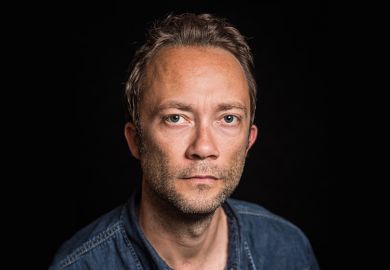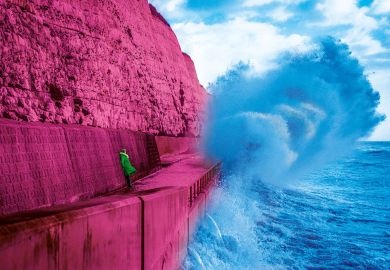As Shelley's body lay burning on the shore at Viareggio, one of the group of mourners watching the Homeric-type cremation was suddenly seized with the desire to grab a souvenir. "The only portions (of Shelley's body) that were not consumed were some fragments of bones, the jaw and the skull," Edward Trelawny recalled, "but what surprised us all was that the heart remained entire. In snatching this relic from the fiery furnace, my hand was severely burnt; and had anyone seen me do the act I should have been put into quarantine."
Trelawny's act of seizing Shelley's heart (now thought most probably to have been his liver) is one of the most famous moments in the development of Shelley's posthumous idealisation. The heart became the centrepiece for the Victorian Shelley shrine near Bournemouth. But the anecdote is also significant for what it tells us about Trelawny. It reveals both his romantic impulsiveness and his calculation. Byron swam out to sea during the cremation, unable to witness the destruction of his friend, but Trelawny watched coldly the "brains literally seething, bubbling and boiling as in a cauldron" and, with an almost modern sense of the power of celebrity, grasped the opportunity, by seizing the heart, of claiming his place in the development of the Shelley myth.
Trelawny has two claims to fame. First, he wormed his way into the Shelley/Byron circle in Pisa, was present at the deaths of both Byron and Shelley and wrote some of the most vivid, if not entirely reliable, memoirs of the two poets. He became, in other words, one of the chief architects of their reputations. Second, and more dramatically, he fashioned his own life until it became a living embodiment of Byron and Shelley's poetic vision. He travelled the world in the navy, he fought in the Greek war of independence, he married a Greek child-bride and he swam across Niagara Falls. He looked like a corsair, with twirling moustache and dark flashing eyes, and he told tales of high-sea adventures, of his years as a pirate or a shark-hunting chief. In effect, he had understood the blurred distinction between life and art that Byron's poetry evoked and had taken it to extremes. While Byron tempered romanticism with ironic detachment, Trelawny, like a performance artist, lived it to the full.
But that is not the whole story, and where David Crane's biography really scores over previous biographies (notably William St Clair's Trelawny: The Incurable Romancer) is in recognising the cruelty and the ruthlessness of Trelawny and his world. Trelawny was quite shameless about exploiting his friendship with Shelley's circle, criticising Byron and Mary Shelley in private correspondence with friends but declaring undying love for them when his public reputation depended on his connection with them. He was heartless with women, engaging in as many actual casual affairs as Byron's mythical heroes were fabled to have done, and abandoning women when they became too old and ugly. And he had a remarkable indifference to pain and brutality, able, for example, to witness the horrific aftermath of the massacre at Tripolis without comment or obvious disturbance.
Indeed it was in Greece that Trelawny's mythical character was finally perfected, and Crane's chapters on the Greek war of independence are the most interesting in the book and one of the most evocative accounts available of the war. As the Greeks waged war against the Turks, they split up into bitter factions, with the foreign-backed "government" of Mavrocordato campaigning against the guerrilla brigand Odysseus Androutses. Fighting was often more ferocious between the factions than against the Turks, and Crane paints a vivid picture of sinister intrigue, merciless torture and mass executions and impalings. Trelawny threw in his lot with Odysseus and spent more than a year in a cave high on Mount Parnassus, besieging and being besieged. The campaign ended with his attempted assassination, and Crane devotes much attention to the fascinating Jarvis/Fenton correspondence (not tackled by St Clair), which details the plot that led to Trelawny's betrayal.
Trelawny's life and blatant self-mythologisation lend themselves to biography, and Crane has responded with gusto, asking himself repeatedly to reflect upon the art of writing biography, of turning life into Life, and upon the connection between this and Byronic romanticism. What seems clear from his portrayal is that Trelawny's life actually troubles the Romantic ideology articulated by Byron, Shelley and Keats, making their vision dark, unscrupulous and shallow. But troubling shallowness aside, Lord Byron's Jackal is a great adventure story, and, while some of the comments about present-day Greece seem a little cruel and unfair, it is a gripping read.
Jennifer Wallace is lecturer in English, University of Cambridge.
Lord Byron's Jackal: A Life of Edward John Trelawny
Author - David Crane
ISBN - 0 00 255631 6
Publisher - HarperCollins
Price - £19.99
Pages - 398
Register to continue
Why register?
- Registration is free and only takes a moment
- Once registered, you can read 3 articles a month
- Sign up for our newsletter
Subscribe
Or subscribe for unlimited access to:
- Unlimited access to news, views, insights & reviews
- Digital editions
- Digital access to THE’s university and college rankings analysis
Already registered or a current subscriber? Login



